Newsom orders 2035 phaseout of gas-powered vehicles, calls for fracking ban

California will halt sales of new gasoline-powered passenger cars and trucks by 2035, Gov. Gavin Newsom announced Wednesday, a move he says will cut greenhouse gas emissions by 35% in the nationâs most populous state.
SACRAMENTO â Emphasizing that California must stay at the forefront of the fight against climate change, Gov. Gavin Newsom on Wednesday issued an executive order to require all new cars sold to be zero-emission vehicles by 2035 and threw his support behind a ban on the controversial use of hydraulic fracturing by oil companies.
Under Newsomâs order, the California Air Resources Board would implement the phaseout of new gas-powered cars and light trucks and also require medium and heavy-duty trucks to be zero-emission by 2045 where possible. California would be the first state in the nation to mandate 100% zero-emission vehicles, though 15 countries already have committed to phasing out gas-powered cars.
Toward a more sustainable California
Get Boiling Point, our newsletter exploring climate change, energy and the environment, and become part of the conversation â and the solution.
You may occasionally receive promotional content from the Los Angeles Times.
Newsom did not take executive action to ban the controversial oil extraction method known as fracking but called on the state Legislature to do so, setting up what could be a contentious political fight when lawmakers reconvene in Sacramento next year.
Taken together, the two climate change efforts would accelerate the stateâs already aggressive efforts to curtail carbon emissions and petroleum hazards and promise to exacerbate tensions with a Trump administration intent on bridling Californiaâs liberal environmental agenda.
âIn the next 15 years we will eliminate in the state of California the sales of internal combustion engines,â Newsom said at a news conference in Sacramento before signing the order. âIf you want to reduce asthma, if you want to mitigate the rise of sea level, if you want to mitigate the loss of ice sheets around the globe, then this is a policy for other states to follow.â
Newsomâs executive order calls ending the sale of new gasoline-powered cars by 2035 a âgoal,â but it also orders the Air Resources Board to immediately begin drafting regulations to achieve it by that year.
California Gov. Gavin Newsomâs executive order to ban new combustion cars by 2035 will reshape the California car market.
The governor acknowledged that not everyone would embrace the 100% zero-emissions mandate but emphasized that nothing in his order would prevent Californians from owning gas-powered cars or buying or selling them used.
âWeâre not taking anything away,â Newsom said. âWeâre providing an abundance of new choices and new technology, being agnostic about how we get to zero emissions, but being committed to getting to zero emissions by 2035.â
Newsom said that Californiaâs action will help spur greater innovation for zero-emission vehicles and, by creating a huge market, will drive down the cost of those cars and trucks. More than 1.63 million new cars and trucks are expected to be sold in the state in 2020, according to the California New Car Dealers Assn.
He noted that California is home to 34 manufacturers of electric vehicles and that just under 50% of all the electric vehicle purchases in the country are in this state. Phasing out gas-powered cars will not only reduce the hazards posed by carbon emissions but will also serve as a catalyst to bring more green jobs to California, he said.
Climate scientists and advocates say the world must stop production of gas- and diesel-powered vehicles by 2030 in order to keep global warming to tolerable levels. California and other governments across the world are seeking to achieve carbon neutrality by 2045, and it will take years for vehicles to turn over and be replaced by zero-emission models.
Beau Boeckmann, president of Galpin Motors dealerships in Los Angeles, said the 2035 mandate âsounds a little scary to some at first blush,â but that everything evolves in this changing world, and everyone needs to prepare for it. The auto industry eventually will benefit by doing to right thing, he said.
âPollution is a terrible thing. I grew up in the San Fernando Valley in the 1970s, and you couldnât see across the valley with that brown haze,â Boeckmann said. âL.A. was known for smog like London was known for fog.â
Californiaâs governor called record-breaking heat and wildfires a âclimate damn emergency.â Actions speak louder than words.
Alliance for Automotive Innovation President and Chief Executive John Bozzellas said the electric car market is crucial to auto manufacturers, but âneither mandates nor bans build successful markets.â
State Senate Republican leader Shannon Grove of Bakersfield, which is in the heart of California oil country, criticized Newsomâs order as âextremist,â saying the governorâs time would be better used protecting Californians from wildfires rather than banning cars that most state residents rely on to provide for their families.
âThe fact is that Californians cannot survive without oil and gas or petroleum byproducts,â Grove said. âThese products are not just the gas in our cars, they are the asphalt on our roads, the plastic holding together electric vehicles, medical equipment vulnerable patients rely on, footballs our children play with, telephones, toothpaste, trash bags, and so much more.â
Cathy Reheis-Boyd, president of the Western States Petroleum Assn., noted that Newsom had lined up expensive zero-emission cars as a backdrop to his news conference.
âItâs interesting that the governor was standing in front of nearly $200,000 worth of electric vehicles as he told Californians that their reliable and affordable cars and trucks would soon be not welcome in our state,â she said. âBig and bold ideas only make sense if affordable for us all and backed by science, data and needed infrastructure.â
In his announcement Monday, Newsom stopped short of mandating health and safety buffer zones around oil and gas wells and refineries. His executive order directed the state Department of Conservation to consider such zones as it drafts regulations to protect âcommunities and workers from the impacts of oil extraction activities,â but the agency already is doing so.
Newsom has resisted calls by environmental and public health advocates to implement those zones immediately.
Newsom sharply criticized the Trump administration this month for ignoring the reality of climate change, saying that Californiaâs deadly wildfires, some of the largest in state history, were grim reminders of what lies ahead for the nation if political leaders in Washington donât take action.
âThis is a climate damn emergency,â Newsom said during a tour of the charred landscape around the Northern California town of Oroville. âThis is real, and itâs happening.â
Gov. Gavin Newsom visited an area burned by wildfires in Oroville, Calif., on Friday and called the Trump administration to task for its record on climate change.
While meeting with Newsom in Sacramento last week, Trump expressed skepticism about the scientific evidence of climate change, saying: âItâll start getting cooler. You just watch.â
The state has sued the Trump administration over efforts by the U.S. Environmental Protection Agency to rescind a special federal waiver that permits California to set its own strict pollution controls to improve air quality, the foundation of the stateâs aggressive efforts to combat climate change.
Environmentalists who had urged Newsom to accelerate Californiaâs climate action praised his order to transition to zero-emission vehicles.
Newsomâs order âwill not only address the single largest source of climate and air pollution in California but is a major step toward boosting his stateâs economic competitiveness and helping Californians who are suffering extraordinary harms from air pollution,â said Fred Krupp, president of the Environmental Defense Fund.
At the same time, many other environmental groups faulted him for not doing more to restrict fossil fuel production and to protect the health of people living nearby.
âIf your climate leadership does not include relief for hundreds of thousands of Californians â the majority people of color â living with oil drilling in their neighborhood, then you are not serious about climate justice,â said Martha ArguĂŤllo, executive director of Physicians for Social Responsibility-Los Angeles.
In November, Newsom imposed a temporary moratorium on new hydraulic fracking permits, saying he wanted them to undergo independent scientific review. Since April, however, his administration has issued close to 50 new permits to Chevron and Aera Energy, frustrating environmentalists.
Legislation to put mandated minimum space between oil wells and homes, as well as schools and playgrounds, failed passage in a California Senate committee.
âNewsom is really good at making announcements that sound big, but they actually arenât. We canât let the fact that heâs acting on cars eclipse the fact that heâs still protecting the oil industry,â said Kassie Siegel, director of the Climate Law Institute at the Center for Biological Diversity.
Siegelâs organization this week threatened to sue Newsom unless he halted all new permits for gas and oil wells in the state, saying the governor has failed to protect the health of vulnerable Californians from pollutants released by the stateâs petroleum industry.
Since taking office, Newsom has faced pressure from politically influential environmental groups to ban new oil and gas drilling and completely phase out fossil fuel extraction in California, one of the nationâs top petroleum-producing states.
But the Democratic governor has pushed back, promising to take a more measured approach that addressed the effects on oil workers and California cities and counties that are economically dependent on the petroleum industry.
California has 1,175 active offshore wells and 60,643 active onshore wells. In 2019, the state produced just under 159 million barrels of oil, CalGEM records show. The stateâs annual crude oil production has been consistently declining since 1985.
California oil industry representatives have argued that phasing out oil production in the state, which has some of the strictest environmental regulations in the world, would force more oil to be imported by train and tanker ship from countries that do not have the same environmental safeguards. According to the Western States Petroleum Assn., there are more than 26 million vehicles with internal-combustion engines in California.
Newsomâs order directs the state Air Resources Board to develop and propose regulations that require increasing volumes of new zero-emission passenger vehicles sold, âtowards the target of 100% of in-state sales by 2035.â
The order also tasks air quality officials with crafting similar rules to ensure all trucks moving freight through the stateâs seaports are zero-emission by 2035. That mirrors targets set three years ago by the mayors of Los Angeles and Long Beach aimed at slashing emissions from the San Pedro Bay port complex, which remains Southern Californiaâs biggest single source of smog-forming pollution.
Across California, cars, trucks and other vehicles are the largest emitters of greenhouse gases, accounting for about 40% of the statewide total, and their emissions have been stubbornly creeping upward in recent years. Driving down transportation pollution remains the stateâs biggest challenge in achieving its goal of slashing planet-warming emissions to 40% below 1990 levels by 2030.
Joe Biden vows he wonât ban fracking. But in Pennsylvania, many voters are skeptical, and Trump is exploiting their anxieties in a key battleground.
Under current regulations, Californiaâs Air Resources Board requires automakers to sell electric, fuel cell and other zero-emission vehicles in increasing percentages through 2025. Electric and plug-in hybrid vehicles accounted for 7.6% of new car registrations in California in 2019.
In 2018, under then-Gov. Jerry Brown, the state set a goal to put 5 million zero-emission cars on the road by 2025. There were 670,000 zero-emission vehicles sold in California through the end of 2019, according to auto industry sales data.
In June, the Air Resources Board adopted the nationâs first sales mandate requiring heavy-duty truck manufacturers to sell increasing percentages of electric or fuel cell models until all new trucks sold in California are zero-emission by 2045.
But efforts to completely phase out gas-powered cars have not gained traction. Three years ago, Brown directed the stateâs chief air quality regulator, Mary Nichols, to look into stepping up the stateâs timetable. Prior to Wednesday, her agency had only floated the idea of banning gas-powered vehicles in congested areas of the state. And legislation lawmakers introduced in 2018 that would have banned the sale of new, gas-powered vehicles by 2040 didnât move forward.
State Assemblyman Phil Ting (D-San Francisco), who wrote that legislation, said âthe fastest way to make the biggest dent in slowing the effects of global warming is to embrace cleaner carsâ and applauded Newsom âfor putting us on a path thatâs not only crucial for our planet, but also helpful in spurring green jobs as we recover from COVID-19.â
Nichols said Wednesday that the Air Resources Board is ready to move forward with the governorâs zero-emissions order and that its scientists, engineers and lawyers âare working to try to figure out how we can deal with the persistence of smog that makes people sick and also at the same time try to get ahead of this escalating climate problem.â
She expressed confidence that the Trump administrationâs efforts to remove Californiaâs authority to set stricter emissions standards, which the state is currently fighting in court, would not pose an obstacle to the governorâs new mandate.
âWe believe the Clean Air Act gives us the authority to set exactly the kinds of standards that we have set since the late â60s,â Nichols said, âand therefore we look forward to being able to do that in the future.â
Times staff writer Russ Mitchell contributed to this report.
Trump and Biden hold radically different views on environmental policy and climate change. Hereâs what voters can expect from the next president.
More to Read
Sign up for Essential California
The most important California stories and recommendations in your inbox every morning.
You may occasionally receive promotional content from the Los Angeles Times.
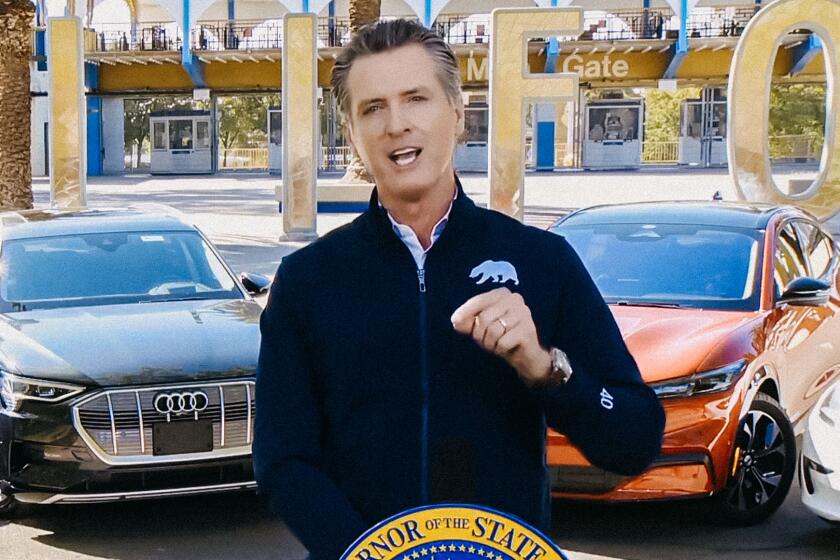
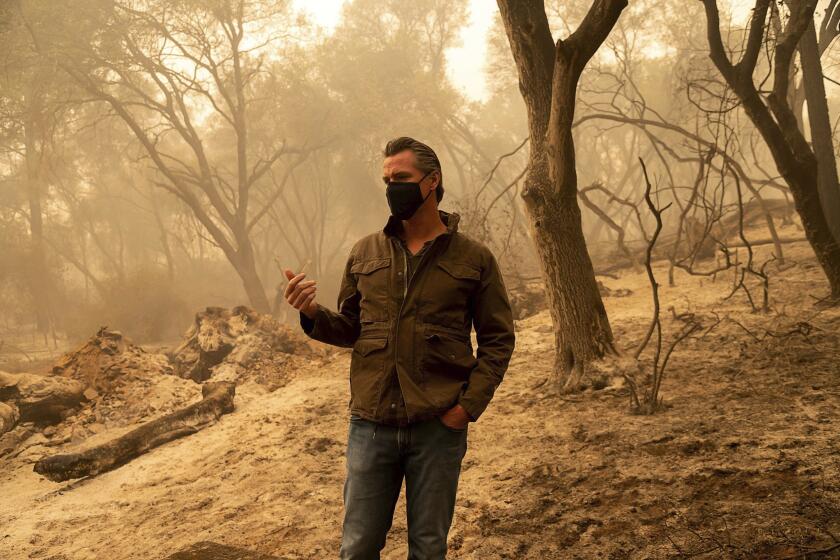
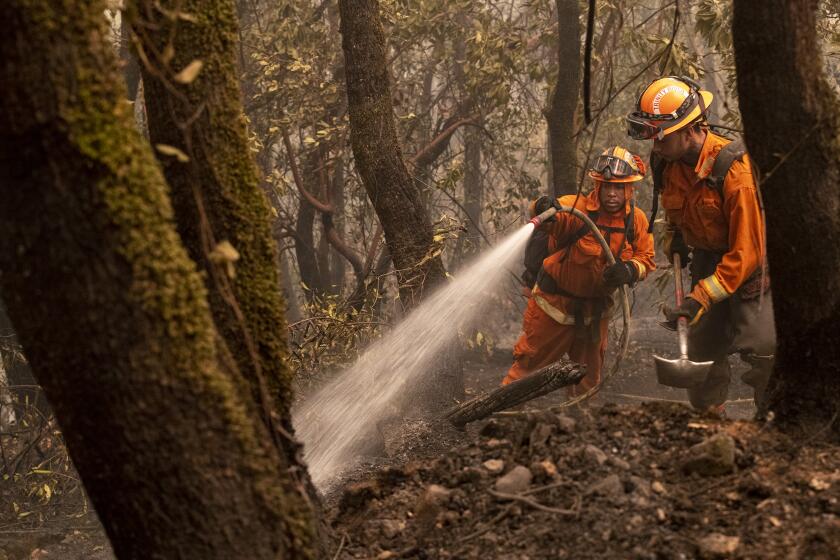
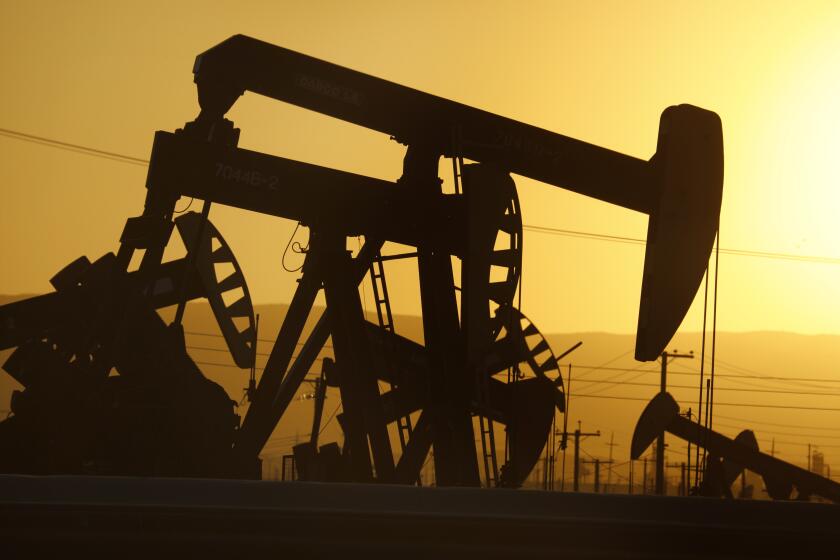
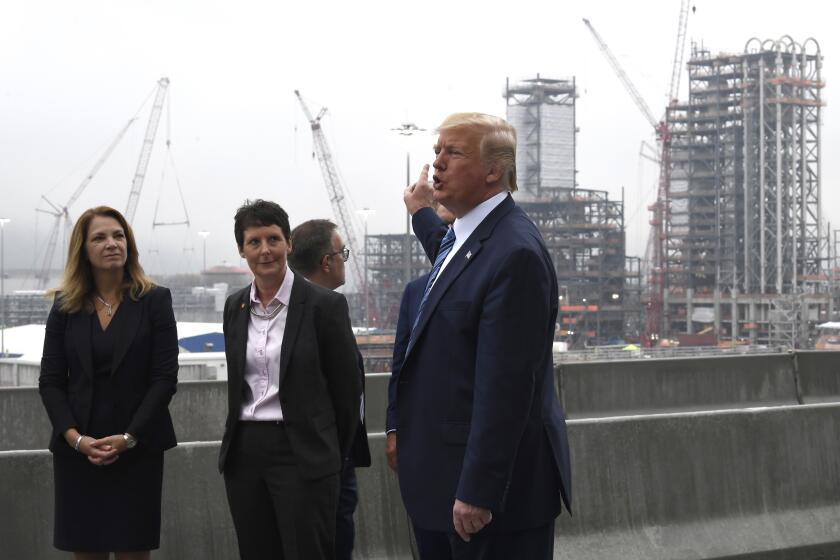
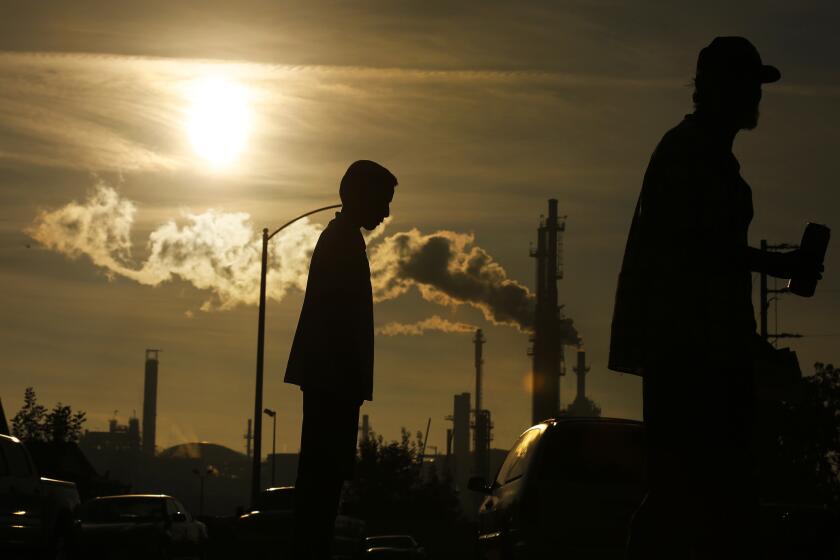





![[20060326 (LA/A20) -- STATING THE CASE: Marchers organized by unions, religious organizations and immigrants rights groups carry signs and chant in downtown L.A. "People are really upset that all the work they do, everything that they give to this nation, is ignored," said Angelica Salas of the Coalition of Humane Immigrant Rights. -- PHOTOGRAPHER: Photographs by Gina Ferazzi The Los Angeles Times] *** [Ferazzi, Gina -- - 109170.ME.0325.rights.12.GMF- Gina Ferazzi/Los Angeles Times - Thousands of protesters march to city hall in downtown Los Angeles Saturday, March 25, 2006. They are protesting against House-passed HR 4437, an anti-immigration bill that opponents say will criminalize millions of immigrant families and anyone who comes into contact with them.]](https://ca-times.brightspotcdn.com/dims4/default/34f403d/2147483647/strip/true/crop/1983x1322+109+0/resize/840x560!/quality/75/?url=https%3A%2F%2Fcalifornia-times-brightspot.s3.amazonaws.com%2Fzbk%2Fdamlat_images%2FLA%2FLA_PHOTO_ARCHIVE%2FSDOCS%2854%29%2Fkx3lslnc.JPG)






